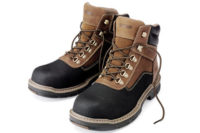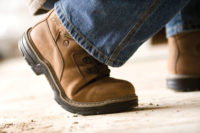Keep your feet warm & dry

Waterproof breathable membranes
For those situations where boots are apt to be exposed to water for long and sustained periods of time, a waterproof membrane will provide the best protection and comfort. Waterproof membranes are also most effective against environments when the boot may become partially and periodically submerged. A waterproof membrane is built into the lining of the boot providing a barrier that prevents any water from entering the inside of the boot. Boots with a waterproof membrane are highly effective in environments where boots are continuously exposed to water. Waterproof membranes offer long-lasting, dependable and durable protection against the elements.
GORE-TEX is widely known for waterproof breathable membranes. Boots and shoes with GORE-TEX are completely waterproof yet highly breathable; perspiration easily escapes through the membrane and water cannot get in. Feet stay dry in more ways than one.
There are many waterproof breathable membranes on the market that perform similarly to GORE-TEX. The breathability of these high quality membranes is the key to their high level of performance.
The very first waterproof footwear was akin to a plastic bag; no water could enter the boot, thus keeping the foot dry; however, no excess heat or sweat could escape either. This made the footwear hot and potentially damp from perspiration.
In more recent years, innovations in membrane technology have progressed significantly. The complex chemical design of modern high-quality waterproof membranes makes them inherently breathable. The material is completely waterproof, while at the same time allowing heat and perspiration to escape from the boot. This makes the boots cooler, dryer and more comfortable to wear. These breakthroughs are especially valuable in boots that are worn for long periods of time and on a regular basis. These breathable waterproof membranes can also be paired with insulation technologies (for example, Thinsulate) for use in cold environments.
Waterproof leathers and seam sealed footwear
The first line of defense against water is waterproof leather and upper materials often combined with internal seam sealing of the boot. This level of waterproof is cost-efficient and effective when used in relatively dry but occasionally wet environments such as rain, mud and puddles. Waterproof leather is also durable and breathable, ensuring feet can stay cool and comfortable. This level of waterproof becomes less effective in environments in which the boot would be periodically and partially submerged in water or any working environments where the presence of water is relatively constant. The degree of waterproofing is enhanced in seam-sealed boots when the upper is relatively simple (few seams) and the bottom is directly injected to the upper.
Street level waterproof
For casual, everyday wear, street level waterproof shoes are satisfactory in many circumstances. From dress shoes to athletic shoes, street level waterproof can even be the most desirable level of waterproof. In street level waterproof shoes, the outsole is made from a waterproof compound so that water does not enter through the bottom of the shoe. In most cases, this level of waterproofing will also apply a seam sealing adhesive inside the bottom of the shoe where the upper and sole meet.
Looking for a reprint of this article?
From high-res PDFs to custom plaques, order your copy today!





